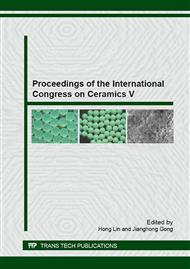[1]
K.K. Cham, A.M. Brownstein, Ceramic membranes growth prospects and opportunities, Am. Ceram. Soc. Bull. 70 (1991) 703-707.
Google Scholar
[2]
K. Ishizaki, S. Komarneri, M. Nanko, Porous Materials-Process Technology and Applications, Kluwer Academic, The Netherlands, 1998 , pp.181-201.
Google Scholar
[3]
Y.C. Dong, J.E. Zhou, B. Lin, Y.Q. Wang, S.L. Wang, L.F. Miao, Y. Lang, X.Q. Liu G.Y. Meng, Reaction-sintered porous mineral-based mullite ceramic membrane supports made from recycled materials, J. Hazard. Mater. 172(2009) 180-186.
DOI: 10.1016/j.jhazmat.2009.06.148
Google Scholar
[4]
J.Y. Cui, X.F. Zhang, H. Liu, S. Liu, K.L. Yeung, Preparation and application of Zeolite/ceramic microfiltration membranes for treatment of oil contaminated water, J. Membr. Sci. 325 (2008) 420-426.
DOI: 10.1016/j.memsci.2008.08.015
Google Scholar
[5]
Li S J, Li N. Effects of composition and temperature on porosity and pore size distribution of porous ceramics prepared from Al(OH)3 and kaolinite gangue. Ceram Int, 2007, 33: 551-556.
DOI: 10.1016/j.ceramint.2005.11.004
Google Scholar
[6]
N.P. Xu, W.H. Xing, Separation Technology and Application of Inorganic Membrane, Chemical Industrial Press, Beijing, (2003).
Google Scholar
[7]
Boccaccini A R, Karapappas P, Marijuan J M, et al. TiO2 coatings on silicon carbide and carbon fibre substrates by electrophoretic deposition. J Mater Sci, 2004, 39: 851-859.
DOI: 10.1023/b:jmsc.0000012914.47793.3e
Google Scholar
[8]
R. Zanetti, Ceramics Make Strong Bid for Tough Membrane Uses, Chem. Eng., 9, 19-22 (1986).
Google Scholar
[9]
B.F. Jones, E. Galan, Sepiolite and palygorskite, in: S.W. Bailey (Ed. ), Reviews in Mineralogy, Hydrous Phyllosilicates, 19, Mineralogical Society of America, Washington, 1988, pp.631-674.
DOI: 10.1515/9781501508998-021
Google Scholar
[10]
Baud, S., Thévenot, F. and Chatillon, C., High temperature sintering of SiC with oxide additives: II. Vaporization processes in powder beds and gas-phase analysis by mass spectrometry. J. Eur. Ceram. Soc. 2003, 23, 9-18.
DOI: 10.1016/s0955-2219(02)00068-7
Google Scholar
[11]
Schubert, C., Adler, J., Schulz, I. and Klose, T., Ceramic membranes with high physical and chemical stability based on SiC and Si3N4. Conference on Materials Research under Environmental Aspects, Dresden 1994, Environmental Aspects in Materials Research. Warlington, 1994, p.283.
Google Scholar
[12]
Singh, M. and Behrendt, D. R., Reactive melt infiltration of silicon-niobium alloys in microporous carbon. J. Mater. Res., 1994, 9, 1701-1705.
DOI: 10.1557/jmr.1994.1701
Google Scholar
[13]
Baud, S., Thévenot, F. and Chatillon, C., High temperature sintering of SiC with oxide additives: III. Quantitative vaporization of SiC–Al2O3 powder beds as revealed by mass spectrometry. J. Eur. Ceram. Soc. 2003, 23, (1927).
DOI: 10.1016/s0955-2219(02)00069-9
Google Scholar
[14]
L.F. Fu, B.A. Dempsey, Modeling the effect of particle size and charge on the structure of the filter cake in ultrafiltration, J. Membr. Sci. 149 (1998) 221-240.
DOI: 10.1016/s0376-7388(98)00169-0
Google Scholar
[15]
M.R. Wiesner, V. Tarabara, M. Cortalezzi, Processes of particle deposition in membrane operation and fabrication, Water Sci. Technol. 51 (6-7) (2005) 345-348.
DOI: 10.2166/wst.2005.0655
Google Scholar


